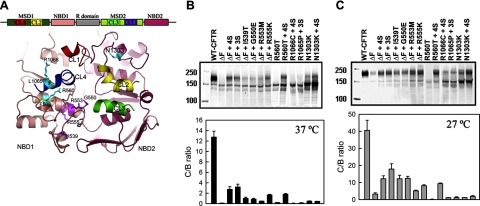Figure 1.
Influence of suppressor mutations in NBD1 on maturation of ΔF508 and other processing mutants. A) Top: schema of CFTR primary structures containing 2 membrane-spanning domains, 2 nucleotide-binding domains, and a regulatory R domain. Bottom: Three-dimensional structure model of CFTR (see ref. 18), colored the same as the schema, with suppressor mutations magenta, F508 yellow, and other maturation-compromising mutations studied in this work cyan. For viewing clarity, the membrane-spanning domains are not shown, except for the 4 cytoplasmic loops (CL1–CL4). B, C) HEK293 cells were transiently transfected with CFTR variants with maturation-compromising mutations introduced in different domains, in the presence or absence of single or combined suppressor mutations (4S: I539T/G550E/R4553M/R555K; 3S: G550E/R553M/R555K). Cells were grown at 37°C and harvested 48 h after transfection (B), or 24 h after transfection, grown at 27°C for another 48 h before harvesting (C). Cell lysates with equal amounts of proteins were subjected to Western blot analysis with anti-CFTR antibody 660. Amount of mature (C band) and immature (B band) CFTR was quantified using the Licor Odyssey IR Fluorescence Imager; C/B ratio was calculated to assess steady-state level of CFTR (n=3–5).

